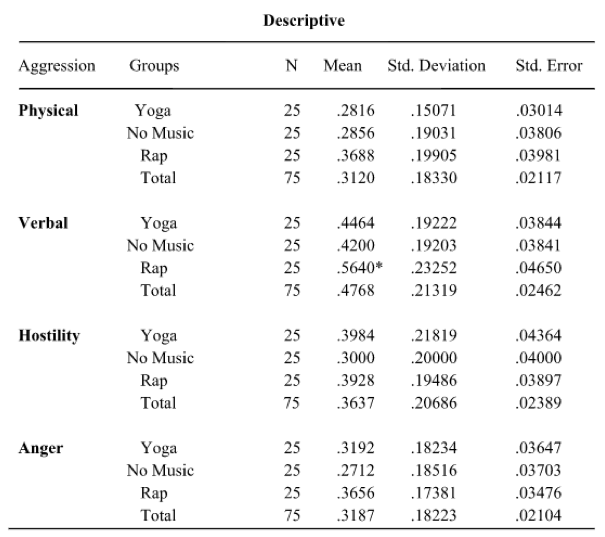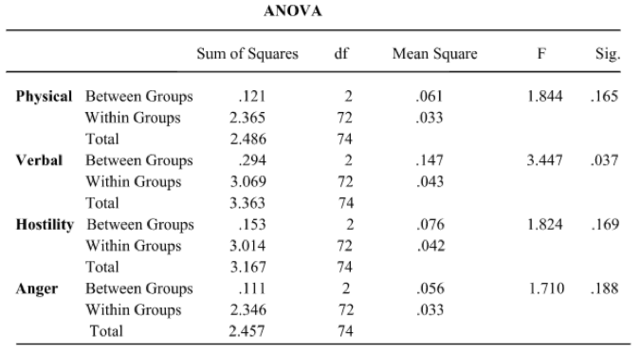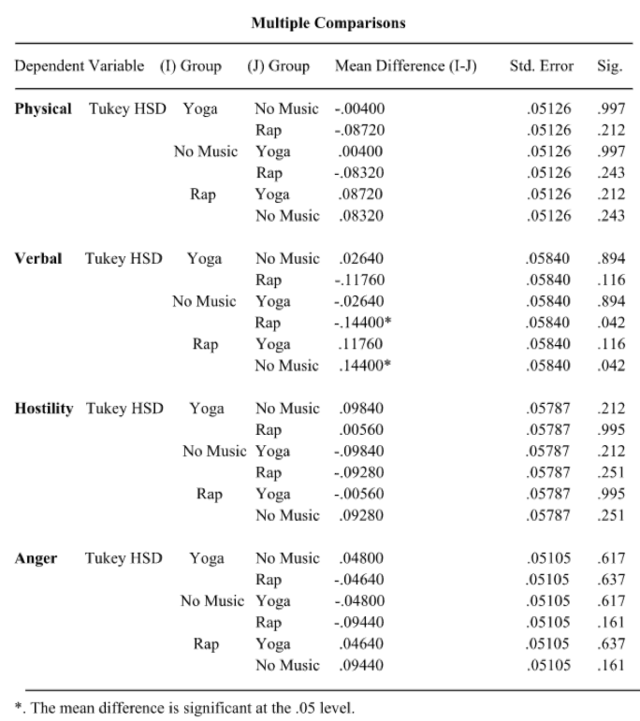The Impact of Music on Emotion: Comparing Rap and Meditative Yoga Music
By
2016, Vol. 8 No. 05 | pg. 1/1
IN THIS ARTICLE
KEYWORDS
AbstractMusic has accompanied major social events throughout the history of mankind. Major gatherings such as weddings, graduations, or birthdays are usually recognized by a familiar tune. There is evidence that music plays a large role in emotional processes within the brain. An individual’s emotional state of mind can directly impact daily cognition and behavior. Studies have shown that music has the ability to regulate a wide range of both positive and negative emotions. This study was conducted to determine the degree of music’s influence on aggression using two extremes of genre: relaxing yoga music versus aggressive rap music. It was expected that those who listened to yoga music would show lower aggression, while those who listened to rap music would have higher aggression. Results demonstrated that listeners of the aggressive rap music scored significantly higher in the dimension of verbal aggression. These findings suggest that aggressive music can make listeners more aggressive emotionally compared to other types of music. The relationship between man and music is a complex one. The ancient Greco-Roman culture believed music penetrated both the body and mind, bringing them into equilibrium. In contrast, Europeans of the late 18th century Romantic Era perceived music as a double-edged sword, capable of both curing and causing disorders (Rose & Bartsch, 2009). It is possible that these societies believed music possessed “magical” properties due to its unexplainable yet observable influence on behavior. The brain seems to have a natural reaction to music, causing listeners to tap their toes, sing aloud, and dance around. However “magical” it may seem, there are clear connections between music, the mind, and behavior. In fact, utilizing the latest in neuroimaging technology, researchers are able to observe how the brain processes auditory information when under the influences of music. Parts of the brain that show an increased activity include areas such as the hypothalamus, responsible for maintaining stress hormones, and the hippocampus, the area vital for emotion regulation (Levitin, 2006).In a PET scan study by Blood and Zatorre (2001), readings indicated that music triggers the same neural processes that govern the brain’s ability to produce feelings of euphoria that are commonly associated with food, sex, and drugs. Blood and Zatorre also noted activations in structures of the brain related to attention and wakefulness when listening to music. The brain is able to convert musical auditory information into stimulation of neural components that are usually associated with emotion, attention, and feelings of euphoria. Based on these findings, what was once thought of as music’s “magical” properties can now be understood as real activations within structures of the brain. As styles of music evolved, so did the understanding of how certain melodies affect the mind. Evidence now suggests listening to music has the potential to stabilize the human psyche by eliciting a wide range both negative and positive emotions. For example, pleasant or relaxing sounds may have the capacity to benefit health by reducing levels of stress. High states of stress can destabilize the human psyche, causing disorders such as illnesses, insomnia, depression, or anxiety. According to research by Bronnimann, Ehlert, Finkel, Marca, Nater, and Thoma (2013), the action of listening to relaxing music aids in stress-related recovery. Participants in this experiment consisted of 60 healthy females between the ages of 20 to 30. The study first exposed a psychological stressor to the participants that triggered their body’s stress response. Subjects were then randomly assigned to one of three condition groups following exposure to stressor: (1) the experimental group listened to relaxing music, (2) control group listened to ambient nature sounds, and (3) another control group experienced no acoustic stimuli. Physiological states that react to stress, such as changes in salivary cortisol and salivary alpha-amylase, heart rate, and respiratory sinus arrhythmia, were monitored to determine music’s recovery effects. It was discovered that the music group showed considerable improvements in autonomic recovery (Bronnimann et al., 2011). In other words, physiological states of high heart rate and abnormal respiratory arrhythmia cycles which are aggravated by emotions of stress were restored to normal levels at a faster rate for the music groups. It is also interesting to note that the group who listened to ambient nature sounds was most effective in respiratory sinus arrhythmia recovery when compared to the music group. Bronnimann et al. (2011) suggested that the human’s subconscious desire to be one with nature may have explained why nature sounds was most effective in bringing individuals to a recovered state after exposure to stressor. This research suggests music’s potential to relieve everyday stressors. Moreover, it is possible that individuals associated ambient nature sounds with perceptions of tranquility and relaxation, and these perceptions may have mitigated aggravated states of stress. Thus, mindfulness of relaxing music helped to stabilize the human psyche. Another possible explanation for music’s effect on behavior is that listening to music does real changes to the body’s physiological states. Vaajoki, Kankkunen, Pietila, and Vehvilainen-Julkunen (2011) studied music’s effect on physiological recovery of post-operation abdominal surgery patients. Vaajoki et al. measured the patients’ respiratory rate, heart rate, and blood pressure on operation day, followed by the next three days. Results indicated that musical intervention lowered blood pressure significantly more in the music group compared to the control group. In regards to long-term effects, the music group also demonstrated significantly better respiratory recovery. Vaajoki et al. suggests that participants slowed their breath rate by matching their breathing with slower songs, which effectively improved their respiratory systems. Whether it was voluntary or involuntary, the human body has a tendency to sync with music. If music has such a great influence on physiological states as Vaajoki suggests, it is possible that songs with faster tempos and aggressive themes can lead to higher respiratory rates, potentially increasing blood flow and heart rate, and possibly leading to exasperated behaviors. While relaxing music may calm the listener, other genres of music, such as faster tempo punk music or heavy metal rock depicting violence and death, may counteractively promote negative emotions and exasperate behaviors. Music has a unique influence on the human psyche because of its connection with emotional processes Music has a unique influence on the human psyche because of its connection with emotional processes. Ehlert, Mohiyeddini, Nater, Ryf, and Thoma (2012) conducted a study to explore this link between music and emotional perceptions. Volunteers were introduced to 16 everyday hypothetical situations that inspired a large range of emotions. These situations, such as “traffic jam” and “going to a party,” involved highly positive and highly negative emotional states. Individuals were instructed to visualize themselves in these emotional everyday situations, as if they were experiencing the events firsthand. Afterwards, participants listened to 20 different styles of songs and were instructed to choose one song they preferred to listen to during the immersion of the hypothetical scenarios. Results indicated that there was a strong correlation between the type of emotion and the preferred style of music. In general, style of songs mirrored the type of emotion in the imagined environment. It appeared that listeners connected certain music to certain emotions (Ehlert et al., 2012). For example, fast paced aggressive songs in minor chords were preferred when participants immersed themselves in high negative emotional events, such as “dispute with partner” or “failed lecture.” In contrast, the high positive emotional events, such as “romantic dinner” or “cozy Sunday,” were commonly matched with softer songs in major chords. In this study, participants had a tendency to choose music connected to the perception of their imagined emotions. In other words, the brain finds ways to connect emotional meaning with auditory stimuli. Since numerous styles of music exist today, it is possible to assume that aggressive music can provoke aggressive behaviors. However, Frith (2008) suggested that music might not necessarily make the listener more hostile, but rather make the listener excited about the thought of being in a negative emotional state. Thus, music genres that are associated with negative themes may influence the mind to perceive aggressive emotions as an entertaining stimulation, rather than cause an observable change in behavior. Though Frith argues that music may not make listeners more aggressive, it is possible that high arousal from music stimulation mixed with aggressive verbal lyrics can induce actual aggressive behaviors for avid listeners of the more “hardcore” genres. Mast and McAndrew (2011) explored this very hypothesis by conducting a study involving the potential relationship between the violent lyrics of heavy metal rock and behavioral aggression. In this experiment, 35 male college students in an undergraduate psychology program were used in the sample. Participants were randomly assigned to one of three groups: (1) a group that listened to heavy metal with intense violent lyrics for eight minutes, (2) a group that listened to heavy metal with non-violent lyrics for eight minutes, and (3) a control group that sat quietly in a room. Afterwards, individuals were given a cup of water and bottle of hot sauce and were instructed to prepare a taste beverage for the next participant. Subjects had the freedom to determine any amount of hot sauce. Results showed that the violent lyrics group added significantly more hot sauce than the other two groups. According to Mast and McAndrew (2011), violent lyrics played a significant role in encouraging aggressive behaviors in the participants. This study suggests a likely link between aggressive genres and aggressive behaviors, possibly due to negative lyrical perceptions and language depicting anger and hostility. Similar areas of the brain that are activated during comprehension of emotions and language in the temporal lobe are also activated when listening to music (Besson, Chobert, and Marie, 2011). Since auditory information of lyrics is translated in the language area of the brain, an area also activated by emotional processes, language from lyrics may give listeners perceptions of emotion. In the study by Mast et al. (2011), it is possible that aggressive lyrics provoked aggressive emotions, leading to more aggressive behaviors. Other musical attributes, such as the type of chord, tempo, or volume may have influenced aggression as well. Songs played in a minor key harmonic have a tendency give listeners perceptions of unsettling emotions such as sadness or anger (Levitin, 2006). Since the PET scans by Blood and Zatorre (2001) demonstrated how music, food, sex, and drugs all share the same reward-based neural operations that govern feelings of euphoria, perhaps in the future it would be possible to use music as a means to regulate and improve a patient’s emotional processes instead of resorting to medication. Music may prove to be a healthy therapeutic alternative. With that goal in mind, the purpose of this current study was to determine the degree of music’s influence on changes in emotion, specifically in the domains of aggression using two extremes of audio categories, relaxing yoga music and aggressive rap music. It was first hypothesized that the yoga music group will have lower aggression levels due to associations with perceptions of positive emotions and relaxation. The second hypothesis was that violent music will increase aggression among listeners due to the presence of aggressive lyrics and perceptions of negative emotions. In sum, it was expected that those who listened to yoga music will score lower in overall aggression, those who listened to rap music will score higher in aggression, and those who did not listen to music would fall in the median. MethodologyParticipants75 volunteers were used for this study. The sample consisted of college students over the age of 18 at the college campus located at the Universities at Shady Grove. The experiment took place in a classroom setting. The students received extra course credit for their participation. MaterialsThe Buss-Perry Aggression Questionnaire (Buss & Perry, 1992) was used to monitor aggression among the participants. The Buss-Perry Aggression Questionnaire is a self-report consisting of 29 aggression related statements. The self-report instructed participants to rate how accurate the 29 items represented themselves on a 1 to 5 scale; ex. “1: extremely uncharacteristic of me” to “5: extremely characteristic of me.” The questionnaire measured four dimensions of aggression: physical aggression, verbal aggression, anger, and hostility. The domains of physical aggression and hostility were used to determine behavioral aggression while verbal aggression and anger corresponded to emotional aggression. Results are calculated on a scale of 0 to 1. In order for music to be played continuously during examination, two aggressive songs and one longer relaxing song were used. Based on the violent lyrics study by Mast et al. (2011), the songs “Andrei the Pit Arlovski” (Freddy Madball & Jaysaun, 2011) and “Ready for War” (50 cent, 2009) were chosen for their aggressive lyrics depicting violence, harsh language, and high musical stimulation from a fast tempo. Similar to the study by Bronnimann et al. (2011) which demonstrated that nature sounds helped to further alleviate stress, “Shadows of White” (Liquid Mind, 1995), the yoga song, was chosen for its gentle nature sounds to promote perceptions of relaxation. ProcedurePrior to administration of the questionnaire, participants were asked to close their eyes and listen to the selection of music for a minute. This allowed listeners to give full attention to the songs being played. Control group did not listen to anything and took the questionnaire immediately. After one minute of acoustic exposure, subjects were instructed to complete the Buss-Perry Aggression Questionnaire (1992) while the selected genre of music continued to play in the background. Music variables were manipulated in three levels, (1) yoga/relaxing music, (2) no music, and (3) rap/aggressive music. Group one listened to “Shadows of White” (Liquid Mind, 1995). Group two had no acoustic stimulus and completed the questionnaire in silence. Group three listened to both “Andrei the Pit Arlovski” (Freddy Madball & Jaysaun, 2011) and “Ready for War” (50 cent, 2009). Answers were entered into the Buss &Perry (1992) online tool for scoring (Available at http://psychology-tools.com/buss-perry-aggression-questionnaire). ResultsTwo extremes of music genres were used to determine music’s influence on aggression. A total of 75 participants (25 per group) were randomly assigned to one of three levels of acoustic stimuli; (1) yoga/relaxing music, (2) control/no music, and (3) aggressive/rap music. The Buss-Perry questionnaire was used to assess four levels of aggression, (1) physical aggression, (2) verbal aggression, (3) hostility, and (4) anger. An ANOVA and post –hoc analysis (with Tukey’s correction) was used to analyze the three levels of the independent variables (music stimuli) with the dependent variables (dimensions of aggression). An alpha level of p < .05 was used for all analyses. Using a one-way ANOVA and post –hoc analysis (with Tukey’s correction), results indicated a significant difference among groups in verbal aggression, F (2, 72) =3.45, p < .05. Post-hoc analysis indicated that participants in the “rap group” scored significantly higher in the dimension of verbal aggression (M =.56, SD=.23) when compared to the “no music” group (M = .42 SD = .19). The differences in verbal aggression between yoga group (M = .45, SD=.19) and no music (M = .42, SD=.19), and yoga group (M = .45, SD=.19) and rap group (M =.56, SD = .23) were not enough to be significant. A one-way ANOVA and post –hoc analysis (with Tukey’s correction) indicated that the three groups did not demonstrate significant differences in physical aggression F (2, 72) =1.844, p > .05, anger F (2, 72) =1.710, p > .05, or hostility F (2, 72) =1.824, p > .05. Thus, no post-hoc analyses were conducted for the other three domains of aggression within groups. DiscussionOverall, this present study was conducted to explore the effects of two extremes of music genres on emotional aggression and behavioral aggression among listeners. It was originally hypothesized that the group listening to relaxing yoga music would result in lower reported aggressions. Results indicated that the first hypothesis was not supported in this case due to no noticeable differences in reported aggression between the yoga group and the control group. However, the data supported the second hypothesis; aggressive music significantly increased a domain of aggression for the listeners in the rap group compared to the control. It is vital to note that music increased aggression only in the domains of verbal aggression. Neither the yoga nor control group had lyrical influences, so it is possible that the presence of violent lyrics in the rap group played a major factor in the differences of verbal aggression. Similar to the study by Mast and McAndrew (2011), the violent lyrics may have played a key role in participants exhibiting some form of aggression. There was also a notable difference in verbal aggression between the rap group and yoga group, but not enough to be significant. Participants in the rap group also scored slightly higher in the domains of physical aggression and anger when compared to the other two groups, but the difference again was not enough to be significant. Evidence from this study indicates that music may have some effect on emotion, depending on the genre. It is probable that the rap group rated themselves as more aggressive due aggressive lyrics, which activated similar areas in the brain that govern emotional and lingual processes (Besson, Chobert, and Marie, 2011). Music’s activation of aggressive emotions may instigate aggressive perceptions and behaviors. Since Frith (2008) suggests music only provides listeners with an enjoyable perception of aggression in an artistic aspect, rather than inducing actual aggressive behavior, the Buss-Perry Questionnaire was used to isolate four types of aggression in two categories; emotional aggression (anger and verbal aggression) and behavioral aggression (physical aggression and hostility). Aggressive music led to a change in emotional aggression (assuming verbal aggression as a form of emotional aggression), rather than a change in behavioral aggression between the rap group and control. In contrast to Mast and McAndrew’s (2011) observations where violent lyrics made listeners behave more aggressively, Frith’s idea holds true in this present study since, there was no observable change in behavior. Since there was only an increase in the domain of verbal aggression for the rap group compared to the control, it is safe to suggest aggressive lyrics can make listeners more emotionally aggressive. Music’s activation of aggressive emotions may instigate aggressive perceptions and behaviors For example, an avid listener of aggressive lyrics may not necessarily be more inclined to harm another person, but may have more of a tendency to utilize aggressive language. The idea that violent music can lead to change in aggressive behaviors is still debatable. Attentional and memory cues may also have played a role in this study. When listening to music, fMRI scans show increased activity in the hippocampus (Levitin, 2006). The hippocampus is the area of the brain that is responsible for emotion regulation, memory retrieval, and behavior inhibitions. The neural processes that involve memory recall and emotional consolidation are closely tied together. Blood and Zatorre (2001) also noted similar activations in structures related to attention. The survey often contained questions regarding the participant’s past actions and behaviors. The presence of aggressive music might have directed attention towards aggressive emotions, leading to more vivid perceptions of aggressive memories. Similar to the study by Ehlert et al. (2012), where participants had a habit of matching music with emotions, subjects may have rated themselves to be more aggressive because of musical perceptions of aggression that cued aggressive emotions and memory. it is possible that the rap group scored highest in verbal aggression for the following reasons: (1) aggressive music can stimulate listeners on a physiological level, increasing respiratory rate, blood pressure, and heart rate, possibly leading to a more unstable psyche, (2) listeners associated negative musical connotations, such as fast tempos and minor harmonic chords, with negative emotions, focusing their attention towards aggressive emotions and memory, or (3) exposure to aggressive lyrics led to activation of neural processes that consolidate perceptions of aggressive language and emotions. The self-report method used to analyze aggression levels of participants was a limitation of this study. Generally, self-reports are not reliable in measuring aggression compared to other means. Completing a questionnaire in a social classroom setting instead of a real world setting may have also influenced the results. Future studies may want to benefit by utilizing other methods including physiological or behavioral observations when comparing music and emotion. Another limitation of this study was the narrow scope of demographics. The sample used in this study consisted of a convenient sample of younger college students. Expanding the study to other demographics with diverse tastes in music may yield different results. it is still unclear whether music has a direct impact on emotional processes; however, evidence from this present study suggests a strong relationship between listening to aggressive music and verbal aggression. It seems that the ancient Greco-Roman and European Romantic view of music was not too far off; what was once thought as “magical” can now be understood as real changes on a psychological and physiological level. It appears that music does have the ability to aid and disrupt in the stabilization of the human psyche. Research by Bronnimann et al. (2013) and Vaajoki et al. (2011) demonstrated how relaxing music can have profound effects on health, aiding in several physiological recoveries. On the other hand, results from the study by Mast et al. (2011) and this current study suggest that aggressive music can increase certain forms of aggression. The human psyche has a unique ability to synchronize external audio stimuli from music with certain emotions. Future research may want to further explore this connection between emotions and music; the same concepts that was once perceived as “magical.” Perhaps one day it would be possible to use music to regulate moods instead of resorting to drugs. Based on these studies, it is clear that music has a very unique effect on the body and mind. This connection should go on to be a continuous and intriguing research topic among scholars and scientists in the future. ReferencesBesson, M., Chobert, J., & Marie, C. (2011). Language and music in the musician brain. Language and Linguistics Compass, 5, 617-634. doi: 10.1111/j.1749-818x2011.00302.x Blood, A.J., & Zatorre, R.J. (2001). Intensely pleasurable responses to music correlate with activity in brain regions implicated in reward and emotion. The National Academy of Sciences, 98, 11818-11823. doi: 10.1073/pnas.191355898 Bronnimann, R., Ehlert, U., Finkel, L., Marca, M.V., Nater, U.M, R.L., & Thoma, M.V. (2013). The Effect of music on the human stress response. PLoS ONE, 8, e70156. doi:10.1371/journal.pone.0070156 Brown, S. (2000). The ‘Musilanguage’ model of music evolution. The Origins of Music, 271-301. Buss, A. H., & Perry, M. P. (1992). The aggression questionnaire. Journal of Personality and Social Psychology, 63, 452-459 Buss, A. H., & Perry, M. P. (1992). The aggression questionnaire. Retrieved from http://psychology-tools.com/buss-perry-aggression-questionnaire/ Ehlert, U., Mohiyeddini, C., Nater, U.M., Ryf, S., & Thoma M.V. (2012). Emotion regulation through listening to music in everyday situations. Cognition & Emotion, 26, 550-560. doi:10.1080/02699931.2011.595390 Frith, S. (2008). Why does music make people so cross? Nordic Journal of Music Therapy, 13, 64-69.doi: 10.1080/08098130409478098 Gebauer, L., & Kringelbach, M.L. (2012). Ever-changing cycles of music pleasure: The role of dopamine and anticipation. Psychomusicology: Music, Mind, and Brain, 22, 152-167. doi: 10.1037/a0031126 Lazarus, R. S. (1999). Stress and emotion. New York: Springer Publishing Company. Levitin, D.J. (2006). This is your brain on music: The science of a human obsession. New York: Penguin Group. Mast, F. J., McAndrew T. F. (2011) Violent lyrics in heavy music can increase aggression in males. North American Journal of Psychology, 13, 63-64. Rose, J. P., & Bartsch, H. H. (2009). Music as therapy. Medicine and Music, 70, 5–8. Vaajoki, A., Kankkunen, P., Pietila, A., & Vehvilainen-Julkunen, K. (2011). Music as nursing invention: Effects of music on blood pressure, heart rate, and respiratory rate in abdominal surgery patients. Nursing and Health Sciences, 13, 412-418. doi: 10.111/j.1442-2018.2011.00633.x Yehuda, N. (2011). Music and stress. Journal of Adult Development, 18, 85-97. doi: 10.1007/s10804-010-9117-4 Suggested Reading from Inquiries Journal
Inquiries Journal provides undergraduate and graduate students around the world a platform for the wide dissemination of academic work over a range of core disciplines. Representing the work of students from hundreds of institutions around the globe, Inquiries Journal's large database of academic articles is completely free. Learn more | Blog | Submit Latest in Psychology |





















